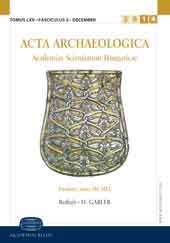Der spätbronzezeitliche zweiteilige bronzebrustpanzer aus der Donau in Ungarn
The late Bronze Age two-piece bronze breastplate from the Danube in Hungary
Author(s): Éva Petres, Katalin JankovitsSubject(s): Archaeology
Published by: Akadémiai Kiadó
Keywords: bipartite bronze cuirass; archaeometallurgical analyses; Aegean, late Bronze Age cuirasses from the Danube region; miniature cuirass from the hoard find of Brandgraben (Steiermark); cuirass from Saint
Summary/Abstract: The Szent István Király Museum of Székesfehérvár bought the cuirass, which had been found in the Danube near Pilismarót, from a private collector in 1982. The breast and back plates of the cuirass were built of bronze plates. The complete cuirass is a unique item and it belongs to the group of cuirasses found in the Danube region [Èaka (Cseke), Ducové (Ducó), Èierna nad Tisou (Ágcsernyő), Nadap, Pázmándfalu]. An intact armour was found in grave 12 of Dendra in the Aegean, which was composed of a high, separate neck guard, interlocked plates and a coat-of-chain built of two parts underneath. Two fragmentary cuirasses of the same type are known from the settlement of Thebes. They are dated from the LH II-III A2/B1 period. The shape of the cuirass from the Danube and its high neck guard are similar to the miniature bronze cuirass, worn as a pendant, from the hoard find of Brandgraben (Steiermark) dated from Bz D-Ha A1 and the bipartite cuirass found in the Seine at Saint-Germain-du-Plain. On this cuirass from the Danube, flat rivets hold the two plates together on both sides. Similar, although conical rivets were used in the cuirasses from Èierna nad Tisou and Saint-Germain-du-Plain. A motive of semicircular, punched dots can be seen on the bottom of the back plate of the cuirass from the Danube. This and the solution of the shoulder strap on the right shoulder show similarity to the cuirass from Saint-Germain-du-Plain. The finely punched dot row (“Gleich-Buckel-System”) and the plastic rib are characteristic decorations of the cuirasses of the Danube region. The cuirass from the Danube cannot exactly be dated in lack of accompanying finds nevertheless the listed characteristic suggest that it came from the Bz D-Ha A1 period.
Journal: Acta Archaeologica Academiae Scientiarum Hungaricae
- Issue Year: 65/2014
- Issue No: 1
- Page Range: 43-71
- Page Count: 29
- Language: German
- Content File-PDF

